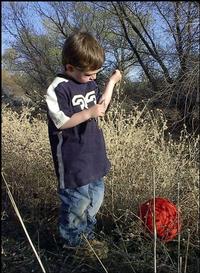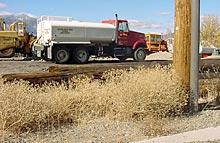Impacts and Spread of Invasive Weeds
Invasive weeds reproduce profusely by seed and/or root, outcompeting native and other desirable plants. Invasive weeds can damage our forests, roads, parks, neighborhoods and natural areas. Once established, weed infestations are expensive to control and can:
- reduce land values,
- damage water quality and clarity,
- contribute to soil erosion, and
- degrade wildlife habitat.
The most effective, economical, and ecologically sound method of managing invasive plants is to prevent their invasion in the first place. We still have a chance to protect the Lake Tahoe Basin from weed invasion, since most current infestations are small and controllable.
Impacts on recreation areas:
- Invasive weeds take over trails and permanently damage meadows, wetlands, lakes and streams.
 Invasive weeds like Yellow starthistle can make hiking trails unusable. Photo by Sue Donaldson
Invasive weeds like Yellow starthistle can make hiking trails unusable. Photo by Sue Donaldson
Impacts to landowners or summer homeowners:
- Invasive weeds reduce land values and can be very expensive to control.
- Invasive weeds reduce soil stability, contributing to increased soil erosion.
Impacts on boaters and fisherman:
- Aquatic invasive weeds clog marinas, damage fish spawning areas, and foul swimming areas.
How are invasive weeds introduced and spread? What can I do to help?
- Plant parts and seeds can stick to your clothing and equipment when using trails and other recreation areas. When leaving an area be sure to remove plant parts and seeds from your clothing, boots, tires, vehicle undercarriages — and the family dog! Dispose of them in a sealed bag in the garbage.
- Help stop the spread of aquatic invasive weeds — always inspect your boat, trailer, and boots/waders and remove plant parts, animals and mud before going from one area or body of water to another. Learn more about aquatic weeds.
- Ornamental plants in gardens and landscaped areas can "jump the fence" to invade neighbor's property and natural areas. Many times, the invasive nature of these plants was not fully understood before they were used in a garden or landscaping setting. Learn which ornamental plants can be invasive in our area.
- Invasive weeds love to grow on sites where the soil has been disturbed such as along roads, at new building and construction sites or where fire fuel-load reduction and defensible space projects have just been completed. Equipment and materials used to complete these site-disturbing projects can bring in seeds and plant parts that can start new infestations.
 Invasive plants like Diffuse knapweed (foreground) can be moved from infested areas to new locations on vehicles and equipment. Photo by Wendy West
Invasive plants like Diffuse knapweed (foreground) can be moved from infested areas to new locations on vehicles and equipment. Photo by Wendy West - Weed seeds and plant parts get stuck on tires and undercarriages of equipment and vehicles. When the vehicle moves from an infested area to a new area the seeds/plant parts can fall off and start a new infestation. Make sure vehicles and equipment are cleaned before coming onto your property.
- Weed and plant parts can be transported in construction and road materials like gravel, road base, erosion control materials and mulches. Request weed-free materials for use in construction projects.
- Identify and eradicate small infestations, before they become difficult and expensive to control. The best defenses against invasive weeds are prevention of introductions and early detection and eradication, before new infestations get established.

